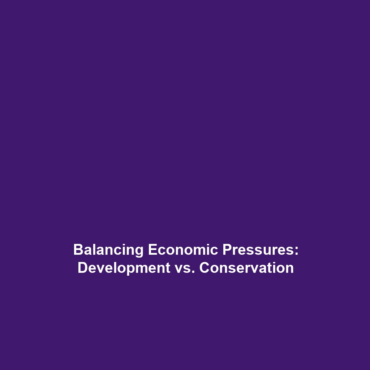Economic Pressures: Balancing Development and Conservation
Introduction
Economic pressures have increasingly come to the forefront of discussions surrounding deforestation and biodiversity loss. The challenge lies in balancing economic development with conservation efforts to protect our planet’s diverse ecosystems. With ongoing industrialization, the demand for land and resources has escalated, often leading to environmental degradation. Understanding these economic pressures is crucial for developing effective strategies that foster sustainable growth while preserving biodiversity. This article explores the significance of finding equilibrium between development and conservation in combating the issues of deforestation and biodiversity loss.
Key Concepts
Several key concepts help elucidate the relationship between economic pressures and conservation:
1. Sustainable Development
Sustainable development emphasizes the importance of meeting present needs without compromising the ability of future generations to meet their own. This principle is vital when considering how economic growth can coexist with conservation efforts. Implementing practices like sustainable forestry and eco-tourism can effectively mitigate the impact of economic expansion on forested areas.
2. Economic Incentives for Conservation
Economic incentives, such as payments for ecosystem services (PES), can motivate stakeholders to engage in conservation. These programs compensate landowners for maintaining ecosystem services, effectively aligning economic and environmental goals.
3. Environmental Policy and Regulation
Policy frameworks and regulations play a significant role in directing economic activities towards sustainable practices, thus minimizing the economic pressures that lead to deforestation and biodiversity losses. Through effective governance, it becomes possible to implement measures that promote conservation while allowing for economic development.
Applications and Real-World Uses
The applications of balancing economic pressures with conservation are evident across various sectors:
- Agroforestry: This approach integrates trees and shrubs into agricultural landscapes, enhancing biodiversity while providing economic benefits to farmers.
- Sustainable Tourism: Eco-tourism initiatives encourage visitors to appreciate and conserve natural habitats, generating revenue while protecting the environment.
- Green Certifications: Businesses adopting sustainable practices can receive certifications that enhance their marketability and appeal to environmentally-conscious consumers.
Current Challenges
Despite the potential benefits of balancing economic pressures with conservation, several challenges persist:
- Conflicting Interests: Stakeholders often have competing priorities, making collaboration difficult.
- Lack of Awareness: Many communities are unaware of the long-term benefits of conservation versus short-term economic gains.
- Insufficient Funding: Financial resources for conservation initiatives are often limited, affecting the implementation of sustainable practices.
Future Research and Innovations
Future advancements related to economic pressures on conservation may focus on:
- Technological Integration: Utilizing AI and big data to optimize land use and minimize environmental impact.
- Green Finance: Developing innovative financing mechanisms to support sustainable projects.
- Policy Innovations: Researching new regulatory frameworks that incentivize conservation while promoting economic growth.
Conclusion
In conclusion, understanding economic pressures is essential for developing effective strategies that balance development and conservation amidst ongoing challenges of deforestation and biodiversity loss. Continued research and collaborative efforts can help reconcile these competing interests. To learn more about sustainable practices and their impact on our ecosystems, explore our additional articles on sustainable development and biodiversity conservation strategies.

